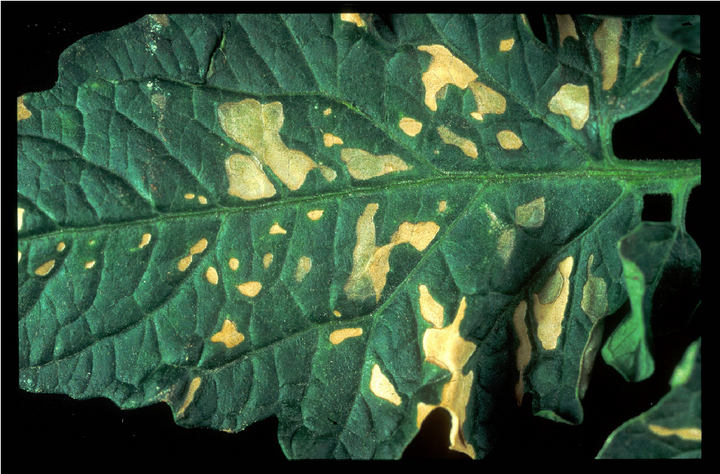Bacterial canker of tomato
Clavibacter michiganensis ssp. michiganensis
Profile
Bacterial wilt of tomato is caused by the bacterium Clavibacter michiganensis ssp. michiganensis . Symptoms of the disease are wilting of the plant and "bird's eye spots" on the tomatoes. Bacterial wilt results in significant yield loss. Clavibacter michiganensis ssp. michiganensis is listed as a Union regulated non-quarantine pest.
Damage symptoms

The first symptoms are reversible wilting of plants at higher temperatures. The bacteria multiply in the vessels and clog them, therefore often only one half of the leaf or plant withers. The vessels of diseased plants are discolored yellow-brown. Bacterial slime can be squeezed out of them. Brown spots (necroses) also appear between the leaf veins. These necroses are the first signs of bacterial wilt infestation, without any wilt symptoms being observed on the plants yet. In the advanced stage of the disease, irreversible wilting finally occurs and the plants wither. The so-called "bird's eye spots" appear on the fruits. These are 2 to 4 mm large spots with a brown, crater-like torn center surrounded by a white yard. These bird's-eye spots occur more frequently after de-pitting and in damp weather. Brown, hollow areas may appear inside the fruit, and seeds are often not formed. If plants grow from infected seeds, symptoms are not seen on them until the first fruits are formed.
Host plants
In addition to the tomato(Lycopersicon esculentum), other species of the genus Lycopersicon are also affected. Some wild plants of the nightshade family (Solanaceae), such as black nightshade (Solanumnigrum), three-flowered nightshade(Solanum triflorum) and Solanum douglasii , also serve as host plants. The bacteria can also survive on weeds and plants that do not belong to the nightshade family. However, these plants are not infected. Infestation of eggplant and peppers has also already been detected.
Distribution
In addition to Austria, the disease is also found in Europe, for example, in Belgium, the Netherlands, France, Germany, the Czech Republic, Hungary, Italy, Spain, Portugal, Switzerland, Poland and Greece. Furthermore, for example, in Israel, India, Turkey, Egypt, Tunisia, South Africa, Canada, USA, Mexico, Cuba, Argentina, Australia, New Zealand and many more countries.
Propagation and transmission
The bacteria can be transmitted with the seeds to which they adhere externally. Studies have shown that seed transmission is no more than 1%. However, contaminated seeds have the greatest significance as primary sources of infection. Infected tomato seeds grow into diseased seedlings, from which the disease can be further spread.
If bacterial mucilage oozes from the plants, the disease is spread in a stand of plants primarily through water droplets and cultural operations (budding, tying and wrapping, pest management treatments, harvesting operations) and rubbing of plants against each other. Bacteria enter plants through stomata or other natural openings (hydathodes) in plants, and also through hair follicles, wounds, and roots. On fruit, infection can also occur through direct penetration. Tomato plants are highly susceptible to this disease throughout their life. As a rule, young plants are somewhat more susceptible than older plants. Once infection has occurred, a long latency period follows before the first symptoms become apparent. The bacteria reside in the woody leading tissue (xylem) of the plants, where they also produce toxins (toxic glycopeptides).
The bacteria can survive for extended periods of time in infested plant material in the soil, on objects, and on the greenhouse structure. However, the bacterium itself can only survive in the soil for a very short time. The bacteria also survive on weeds (e.g., Solanum nigrum and other Solanum species). In the nutrient solutions of hydroponic crops, the bacteria can remain alive for several months. On seeds, the bacteria persist for up to eight months.
The disease spreads most vigorously at temperatures between 26 and 28°C. Minor cultivar differences in susceptibility are known.
Prevention and control
- Remove infested plants from the stand and dispose of them. In addition, 10 plants before and 20 plants after the diseased plant in the row should also be removed to be on the safe side.
- Harvesting operations should be carried out in one direction only.
- Culling should be carried out only in dry weather. If done in time, it is possible to break out the stingy shoots by hand without touching the wound sites. If a knife is used, it should be disinfected before each cutting.
- Good humus and water supply mitigate damage from bacterial wilt.
- On infested areas, observe a cultivation break with tomatoes of at least four years.
Phytosanitary status
Clavibacter michiganensis ssp. michiganensis is listed as a Union regulated non-quarantine pest and is transmitted by certain planting material. The presence of such pests results in unacceptable economic consequences with respect to the intended marketing of the planting material. The import and movement within the EU are therefore uniformly regulated for specific seed and planting material.
Last updated: 25.05.2023
automatically translated